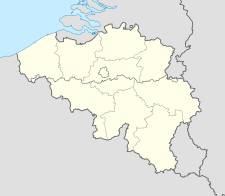Fort Breendonk
| Fort Breendonk SS-Auffanglager Breendonk |
|
|---|---|
| Prison camp | |

A modern view of the camp's entrance
|
|
| Coordinates | 51°03′23″N 4°20′29″E / 51.056389°N 4.341389°ECoordinates: 51°03′23″N 4°20′29″E / 51.056389°N 4.341389°E |
| Other names | SS-Auffanglager Breendonk |
| Location | Breendonk (near Willebroek), Belgium |
| Built by | Belgian Army (part of the National Redoubt of Antwerp) |
| Operated by | SS |
| Commandant |
|
| First built | 1906–13 |
| Operational | September 1940–August 1944 |
| Inmates | Jews, political prisoners, resistance fighters, hostages |
| Notable inmates | Jean Améry, Willy Kruyt, Martial van Schelle, Todor Angelov, Paul Hoornaert |
| Website | Official website |
Fort Breendonk (Dutch: Fort van Breendonk, French: Fort de Breendonk) is a military fortification situated at Breendonk, near Mechelen, in Belgium which is best known for its role as a Nazi prison camp (Auffanglager) during the German occupation of Belgium during World War II.
Fort Breendonk was originally built for the Belgian army between 1906-13 as part of the second ring of defenses of the National Redoubt protecting the important port-city of Antwerp. It was covered by a five-metre thick layer of soil for defense against bombings, a water-filled moat and measured 656 by 984 feet (200 by 300 m).
During World War II, the fort was requisitioned by the Germans as a prison camp for detaining Belgian political dissidents, captured resistance members and Jews. Although technically a prison rather than a concentration camp, the Fort was famous for its prisoners' poor living conditions and for the use of torture. Most prisoners who were detained at the camp were later transferred to larger concentration camps in Eastern Europe. Of the 3,590 prisoners known to have been imprisoned at Breendonk, 303 died or were executed within the fort itself but as many as 1,741 died subsequently in other camps before the end of the war.
Today, the site is a national memorial and museum which is open to the public.
Belgium was invaded in August 1914 by the German army after refusing its request of unhindered passage to northern France.
The invasion began on 4 August 1914. Eager to reach Paris as soon as possible, the German army concentrated all its efforts towards the south, ignoring Antwerp. Continued Belgian resistance from the north forced German command to attack the city. On 9 September, General Beseler was ordered to attack Antwerp. Heavy siege artillery was sent north, having already been used at the sieges of Namur and Maubeuge in France.
...
Wikipedia

